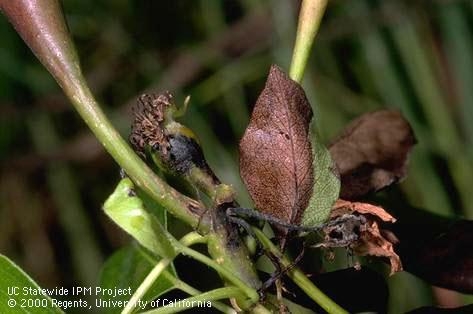Help for the Gardener from the
Contra Costa Master Gardeners' Help Desk
Description of Client's Problem:

Here's the advice that the Master Gardener Help Desk gave the client.
It appears that the problem is Pear Blossom Blast (Pseudomonas syringae) not Fire Blight as we originally thought.
Blossom blast and die back is caused by a bacterial infection and very difficult to treat. Infected buds fail to open, dry out and die. Leaves may be spotted. Flower petals and stems may also be affected, and fruit cluster bases can turn brown or black. Occasionally, fruiting spurs may be killed. Cankers may develop in twigs and branches.
Symptoms of this disease, especially on flowers, may closely resemble fire blight. However, blast infections seldom extend more than 1"-2" into a spur. Bacterial ooze, which is common with fire blight, is not present with Pear Blossom Blast and none could be seen on your samples or pictures. Frost and cold injury promote infection (we did have some pretty cold spells this year). Warm, dry weather inhibits this disease.
Selecting non-chemical management options should be your first choice:
- Avoid wounding plants. (weed wacker too close, branches rubbing, etc.)
- Prevent frost injury when possible. Plant hardy varieties in protected locations.
- Provide proper culture to minimize succulent shoot growth and to reduce injuries.
- Prune out and destroy infected tissues as soon as they are noticed. Make cuts at least 6" below infected areas and sterilize pruning tools between cuts.
Bacterial Blossom Blast is difficult to control. Monitor temperatures and protect against frost, which may help prevent infection. In areas where Blossom Blast is common, copper sprays labeled for this use may be applied in the fall or dormant season, but the efficacy of these treatments is questionable.
Some additional information on Pear Blossom Blast can be found on the UC IPM web site at:
http://www.ipm.ucdavis.edu/PMG/r603100111.html#MANAGEMENT
Editor's Note: Each month the CCMG Help Desk's Quality Assurance Team selects responses to county residents' Help Desk questions that produced informative responses that are either unique or unusual, or provided updated information that would be informative to all gardeners, or are of general interest, especially of seasonal concerns. We are highlighting these responses in the HortCOCO blog so all interested Master Gardeners and the public may utilize the information.
The CCMG Help Desk is available year-round to answer your gardening questions. Except for a few holidays, we're open every week, Monday through Thursday from 9:00 am to Noon at 75 Santa Barbara Road, 2d Floor, Pleasant Hill, CA 94523. We can also be reached via telephone: (925) 646-6586, email: ccmg@ucanr.edu, and we are on the web at http://ccmg.ucanr.edu/